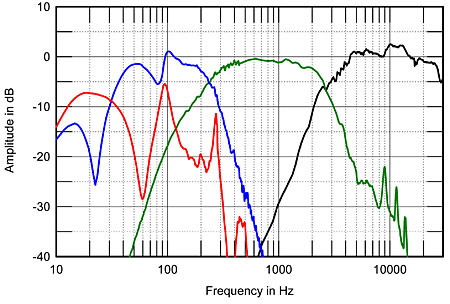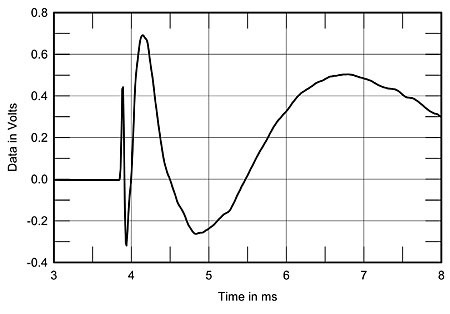| Columns Retired Columns & Blogs |
Snell Illusion loudspeaker Measurements
Sidebar 3: Measurements
My estimate of the Snell Illusion's voltage sensitivity on its tweeter axis was 89.5dB(B)/2.83V/m, which is usefully above average and within experimental error of the specified 89dB. The speaker's plot of impedance magnitude and phase, however, reveals it to be quite a demanding load for the partnering amplifier, the magnitude remaining between 3 and 4 ohms for much of the upper bass and midrange (fig.1). There is also a tricky combination of 4.5 ohms and –48° capacitive phase angle at 50Hz. A good amplifier rated at 4 ohms will be needed to drive the Illusion to high levels without strain.

Fig.1 Snell Illusion, electrical impedance (solid) and phase (dashed). (2 ohms/vertical div.)
The traces in fig.1 are free from the small, sharply defined discontinuities that would suggest the presence of cabinet resonances, but I note that LG did find a section of the sidewall adjacent to the ports that seemed to vibrate strongly. Investigating the enclosure's vibrational behavior with an accelerometer, I found several relatively strong resonant modes on the sidewalls, the highest-level of which lay at 254Hz (fig.2). These could be heard as a touch of overhang with the half-step–spaced toneburst track on Editor's Choice (CD, Stereophile STPH016-2), but the main problem was lower in frequency, around 100Hz, where a distinctly warm character was audible both on the tonebursts and on the bass guitar on my recording of Attention Screen's Live at Merkin Hall (CD, Stereophile STPH018-2).

Fig.2 Snell Illusion, cumulative spectral-decay plot calculated from output of an accelerometer fastened to the center of the side panel 17" from the top (MLS driving voltage to speaker, 7.55V; measurement bandwidth, 2kHz).
The saddle centered on 21Hz in the impedance-magnitude trace suggests that this is the tuning frequency of the two large ports on the cabinet's rear panel, and the nearfield response of the two woofers (they behaved identically) does indeed have the expected minimum-motion notch at that frequency (fig.3, blue trace). However, a second notch is apparent at 90Hz, this almost coincident with a strong resonance in the ports' output (fig.3, red). A second resonance can be seen at 270Hz. The woofers appear to cross over to the midrange units (fig.3, green) at around 240Hz and roll off smoothly above that frequency. The midrange units are very well behaved in their passband, and although three breakup modes can be seen at around 10kHz, these are well suppressed by the crossover. The tweeter (fig.3, black) is also well behaved in its passband.

Fig.3 Snell Illusion, quasi-anechoic responses of tweeter (black) and midrange unit (green) on tweeter axis at 50", corrected for microphone response, with nearfield responses of midrange unit (green), woofers (blue), and ports (red), plotted in the ratios of the square roots of their radiating areas below 350Hz, 750Hz, and 500Hz, respectively.
The Snell Illusion's farfield response, averaged across a 30° horizontal window on its tweeter axis, is extraordinarily flat above 300Hz (fig.4). Below that frequency, the complex sum of the individual nearfield responses is marred by the port resonances mentioned earlier. But, as expected from such a large speaker, the bass is well extended, with the output down 5dB at the port tuning frequency of 21Hz.

Fig.4 Snell Illusion, anechoic response on tweeter axis at 50", averaged across 30° horizontal window and corrected for microphone response, with the complex sum of the individual responses plotted below 300Hz.
The Snell Illusion's lateral dispersion is also superb (fig.5), with smooth, evenly spaced contour lines up to 6kHz, above which the tweeter gets increasingly directional. The slight notch at 17kHz in the on-axis response also fills in to the speaker's sides. The Illusion might sound a little mellow in large rooms, but the smoothness of its off-axis behavior will result in uncolored sound even in reverberant spaces. In the vertical plane (fig.6), the usual suckout develops in the upper crossover region at extreme angles off axis, but the Snell maintains its flat response over quite a wide listening window. This is just as well, considering that the tweeter is a high 42.5" from the ground.

Fig.5 Snell Illusion, lateral response family at 50", normalized to response on tweeter axis, from back to front: differences in response 90–5° off axis, reference response, differences in response 5–90° off axis.

Fig.6 Snell Illusion, vertical response family at 50", normalized to response on tweeter axis, from back to front: differences in response 15–5° above axis, reference response, differences in response 5–15° below axis.
The trace in fig.7 was derived by averaging 20 individual 1/6-octave-smoothed responses for each speaker in a vertical rectangular grid centered on the position of LG's ears in his listening chair. The spatial averaging minimizes the effect of room-acoustics problems, but there are still slight peaks evident at 105 and 55Hz. These can also be seen in the spatially averaged response of the Revel Ultima Salon2 speaker, which LG reviewed in June, but the Snell is actually better balanced than the Revel in the lower midrange. The Snell's midrange and treble are superbly flat in-room, though with a bit more mid-treble energy apparent compared with the Revel. The low bass in-room is down just a couple of dB at 20Hz.

Fig.7 Snell Illusion, 1/6-octave, spatially averaged response in LG's listening room.
Turning to the time domain, the Illusion's step response on its tweeter axis (fig.8) reveals that all five drive-units are connected with the same positive acoustic polarity, this confirmed by looking at the individual step responses. The decay of each drive-unit's step is smoothly integrated with the start of the step of the next lower in frequency, which correlates with the superb frequency-domain integration of their outputs seen in fig.4. Finally, the speaker's cumulative spectral-decay plot on the tweeter axis (fig.9) is very clean, with only a very-low-level ridge of delayed energy evident just above 4kHz.

Fig.8 Snell Illusion, step response on tweeter axis at 50" (5ms time window, 30kHz bandwidth).

Fig.9 Snell Illusion, cumulative spectral-decay plot on tweeter axis at 50" (0.15ms risetime).
In almost every way, the Snell Illusion's measured performance is textbook in nature—which is perhaps to be expected, given that its designer, Joe D'Appolito, literally wrote the book on how loudspeakers should be measured (Testing Loudspeakers, Audio Amateur Press, 1998). But it leaves me all the more puzzled why that port resonance just below 100Hz escaped Dr. D'Appolito's scrutiny. I am told that our review samples were from very early production of the Illusion, and it's also fair to say that this problem occurs right in the middle of the frequency region where room-acoustics resonant modes are endemic. Even so, both Larry Greenhill and I could detect its presence as an added warmth on recordings of bass guitar.—John Atkinson
- Log in or register to post comments




































